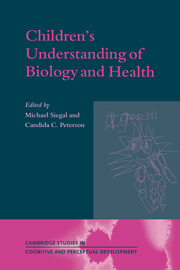Book contents
- Frontmatter
- Contents
- List of contributors
- Preface
- 1 Becoming mindful of biology and health: an introduction
- Part I Development of biological understanding
- Part II Health issues
- Part III Applications
- 9 Considering children's folkbiology in health education
- 10 Young children's understanding of the physician's role and the medical hearsay exception
- 11 Cognitive development and the competence to consent to medical and psychotherapeutic treatment
- Appendix: Hypothetical dilemma vignettes
- Author index
- Subject index
9 - Considering children's folkbiology in health education
Published online by Cambridge University Press: 06 July 2010
- Frontmatter
- Contents
- List of contributors
- Preface
- 1 Becoming mindful of biology and health: an introduction
- Part I Development of biological understanding
- Part II Health issues
- Part III Applications
- 9 Considering children's folkbiology in health education
- 10 Young children's understanding of the physician's role and the medical hearsay exception
- 11 Cognitive development and the competence to consent to medical and psychotherapeutic treatment
- Appendix: Hypothetical dilemma vignettes
- Author index
- Subject index
Summary
A prevalent approach to health education is to focus on dos and don'ts. We are advised to exercise more; eat more fruit and vegetables; take vitamins, folic acid, zinc, and whatever the latest health studies suggest that we should take; reduce our intake of saturated fat, salt, alcohol, and so forth; refrain from smoking; use condoms; wash hands frequently and avoid touching our faces during the flu season; always finish the full course of antibiotics prescribed by our doctors; cook chicken thoroughly; wash hands with soap after handling raw eggs and meat. Even though it is easier to remember things that make sense than to remember a number of unconnected facts (Dooling and Lachman, 1971), health educators typically try to help us remember lists of recommendations by nagging (i.e., sheer repetition) rather than by helping us make sense of the dos and don'ts.
Consider the current approach to AIDS education. In schools as well as the public media, the basic messages in AIDS education are simple (perhaps to a fault): AIDS is deadly, and there is no cure; the best documented ways of getting AIDS are through sharing a needle, sexual intercourse, or getting contaminated blood in a transfusion. Such a list of seemingly unconnected facts about AIDS probably serves more as “food for memorization” than “food for thought.” So, children and adults alike might simply learn and then stow away these facts, much as they do with the names of the capital cities of nations around the world.
- Type
- Chapter
- Information
- Children's Understanding of Biology and Health , pp. 209 - 234Publisher: Cambridge University PressPrint publication year: 1999
- 24
- Cited by



